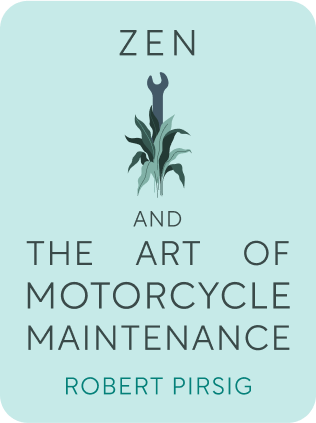

This article is an excerpt from the Shortform book guide to "Zen And The Art Of Motorcycle Maintenance" by Robert Pirsig. Shortform has the world's best summaries and analyses of books you should be reading.
Like this article? Sign up for a free trial here .
How does Robert Pirsig define gumption in In Zen and the Art of Motorcycle Maintenance? What does gumption help you achieve?
Gumption is a huge part of In Zen and the Art of Motorcycle Maintenance. But how do you define gumption? Pirsig lays out some rules about what it means to have gumption.
Keep reading to find out how to define gumption.
Define Gumption: Gumption Traps, and Motorcycle Maintenance
In the morning, Pirsig packs everything up before waking Chris. Made mischievous by the coldness of the morning, Pirsig screams “Wake!” to rouse him and immediately starts reciting Persian poetry (which Chris, in his half-awake state, doesn’t appreciate).
Soon they’re on the road again. As they cross into Oregon, Pirsig is still reciting verses from The Rubáiyat of Omar Khayyám to himself. Chris yells to Pirsig that he has diarrhea again, breaking Pirsig’s reverie. They pull over at a stream, and Chris hops off to clean himself.
Chautauqua: On Gumption
Here’s how you define gumption: in the process of attending to our task with a calm mind, there’s always the possibility that unforeseen problems may arise. Pirsig calls these annoyances “gumption traps,” for they siphon off the initial enthusiasm—the gumption—we feel as we become attuned to Quality and immersed in our work.
Although there are likely an infinite number of gumption traps, Pirsig narrows the field to two main types: Setbacks, which are external circumstances that divert us from the Quality path; and Hang-Ups, which are internal circumstances that do.
An all-too-common setback is the “leftover part” setback. Say, for example, you’re assembling an engine and nearly have it completed…when you discover not only that you’ve forgotten an essential part but also that you have to reassemble the whole thing! A setback like this can absolutely drain your gumption reservoir.
Pirsig offers two techniques to reduce the effects of this particular setback and elaborate on how to define gumption:
Take Disassembly Notes
As you disassemble, make note of any particulars that you think might give you trouble as you reassemble.
Lay Parts Down in Order
Pirsig spreads newspaper on the floor of his garage and lays the parts down left-to-right, top-to-bottom in order of disassembly. When you begin to reassemble, you can pick up the parts in reverse order.
A second common setback is the “intermittent failure” setback. This is a malfunction that seems to fix itself right as you begin to repair it, then later crops up again (typically at the worst possible time). Intermittent failures are a gumption trap because you’re constantly being waylaid for a problem you think you’ve solved.
Make Note of Correlations
Pirsig’s solution to intermittent failures is to pay close attention to what else is going on with the cycle when the failure occurs. Is the road bumpy? Are you making a turn? These correlations can help guide you as you develop hypotheses.
The third most common setback is the “parts” setback. This setback encapsulates a number of challenges involving parts: one, needing them in the first place; two, finding them at a reasonable price; and three, discovering the part you’ve purchased doesn’t fit.
Befriend Your Local Parts Supplier
If there’s more than one parts store in your area, choose the one with the most helpful staff and get to know them. They can be a vital resource for advice (and deals!).
Don’t Sleep on Wholesalers
Dealerships and dedicated cycle shops will occasionally jack up prices on individual parts to compensate for low motorcycle-purchase costs. It can be worth your while to check out chain auto stores or wholesalers, which stock common parts at more reasonable prices. This can help us define gumption.
Do It Yourself
If you have ample time and money, you might investigate machining your own parts. Pirsig uses a 6” x 18” lathe with a milling attachment and welding tools. This solution is doubly beneficial because it’s gumption boosting—nothing speaks Quality like a motorcycle running on parts you’ve created yourself.
As for hang-ups—the internal gumption traps—a major type is the “value” hang-up, which typically manifests itself as value rigidity. This hang-up appears when you diagnose a problem prematurely and discover your solution, based on false premises, doesn’t work. Suddenly your gumption goes out the window—the thing you were positive of has proven untrue.
If you’re too rigid in your values—if you insist that your original idea has to be true—then you’re bound to get nowhere. The solution to this gumption trap is simple.
1. Slow Down
If you’re moving too quickly—racing to the manual, racking your brain for whatever mechanical knowledge you already possess, trying something new without thinking it over—you won’t be receptive to the Quality inhering in the situation.
2. Stare at the Problem
Part and parcel of slowing down is just sitting with the problem. Rather than scurrying for a solution, try to clear your mind and open yourself to a number of possible solutions, from the easy to the impractical.
3. Observe the Facts
As you meditate on your problem, as a fisherman does his line, possibilities—facts—will emerge. They might not be useful ones for this particular task, but they might have value in their own right. You might even find yourself more interested in these ideas than the problem you set out to solve. This is how you know you’re keyed into the Quality of the motorcycle.
The riders stop in Prairie City for lunch, and Chris continues working on his letter to his mother. Pirsig thinks that he might have some value rigidity of his own that’s preventing him from fully understanding his son. Chris’s trouble arises when he tries to imitate Pirsig; he wants to please Pirsig more than anyone else. Pirsig remembers his recurring dream: there’s a barrier between them that prevents them from communicating.
Chautauqua: On Gumption (cont’d)
Pirsig considers further hang-ups:
Ego
A common cause of value rigidity, ego prevents us from acknowledging when we’re at a loss. If we refuse to recognize new facts, either because we’re overly sure of ourselves or afraid of looking silly, we can never access Quality, and our share of gumption is always in danger.
If humility isn’t our default, we can always pretend to be humble. That way, if our solution doesn’t pan out, we get a gumption boost from being proven right. And eventually we’re bound to come to a set of facts that proves us wrong.
Anxiety
This is the near-opposite of ego: We’re so worked up over getting a repair right, we either fail to start at all or fuss so much over it we end up making the problem worse.
One way to beat this gumption trap is to study up on the repair. Read everything you can and take notes, then diagram your project on paper. The actual repair, then, becomes a matter of just following your own instructions.
It might also be comforting to remember that even the most skilled mechanics mess up every once in a while.
Boredom
Boredom often comes along with ego. It means you already know (or think you know) everything you need to to maintain your cycle, and now you’re just going through the motions. You’ve lost the ability to see your cycle anew and be attuned to Quality, which is the wellspring for original ideas.
The best thing to do when boredom strikes is to stop work immediately and do a palette cleanse for your mind. Watch TV, walk around town, even take a nap—these activities can allow you to bring renewed interest to your task.
Another possibility, if you hate doing rote work like cleaning the motorcycle, is to make a ritual out of it. Treat it like a weekly appointment that you have to keep.
Impatience
Few situations sap gumption like underestimating the amount of time a project is going to take. And when you get impatient, the risk of making a major mistake increases, putting you in danger of a gumption blowout.
You have a few choices to avoid this gumption trap. Allotting an indefinite amount of time for a particularly complex project is one; giving yourself double the amount of time you estimate for a project or scaling down your goals for the project are others.
Pirsig classifies all of these hang-ups as value traps; but there are other classes of hang-ups: truth traps and muscle traps.
The principal truth trap is the “yes-no logic” trap. An outgrowth of the classical mode of understanding, yes-no logic misleads us into thinking that for any hypothesis there’s only one of two possible answers. Pirsig, however, introduces a third term: mu.
Mu, Japanese for “nothing” or “the negative,” is a vital term in Zen Buddhism. It intimates that, for a given hypothesis, a yes-or-no answer may not be appropriate—it points us outside the yes-no binary.
In practical terms, mu answers indicate that there’s something in the context of our problem that makes our hypothesis insufficient. For example, if we design an experiment to test a particular motorcycle malfunction and we don’t achieve a clear result, there’s no reason to get frustrated. The likelihood is that our experiment was misdirected given the problem at hand—the context of the problem was larger than we understood when we designed the experiment. In short, mu answers can increase knowledge as much as or more than yes-no answers can.
As for muscle (or psychomotor) traps, the worst is the “inadequate tools” trap—gumption suffers when your tool joins your bike in a state of disrepair. A useful strategy is to buy the most durable and effective tools you can afford, even if you have to get them secondhand. Good tools don’t wear out, so you’re better off buying a reputable used tool than a second-rate new one.
Some muscle traps—like low-lit and uncomfortable working environments—are easily avoidable; but muscle insensitivity—essentially klutziness—is less so. A motorcycle consists of a variety of parts forged from a variety of materials, and each part and material has its own toughness or delicacy. The key is to cultivate a “mechanic’s feel” by staying aware at all times of which parts of the motorcycle you’re working with. If you’re working with the exterior of the cycle, you have a bit more leeway to bang things around; if you’re working with the precision parts of the engine, you need to treat those parts with care (also with softer tools like brass or rubber hammers).
Of course, even if we account for each of these traps, there are still any number that might arise in the course of a repair. Which is why Pirsig says we must live right, too. If we’re falling into gumption traps all the time in our everyday lives and then trying to shape up to maintain our motorcycles, we’ll never succeed. Our external work is a reflection of our internal condition, and so the “cycle” we should always be working on is ourselves.
After a taxing stretch of road that took the riders through desert country, they arrive in Prineville Junction just as evening is coming on. They stop for gas, and Pirsig is so exhausted he plops onto a curb to just sit. Observing the drivers of the cars passing by, Pirsig remembers the biggest gumption trap of all: the self-absorption that comes with the American brand of self-reliance and ambition.
A bit further south, the riders find a forest that has been divided into lots for a development. They pick a lot distant from the road and lie down for the night.
In order to define gumption, Pirsig has to explain life and his learnings.

———End of Preview———
Like what you just read? Read the rest of the world's best book summary and analysis of Robert Pirsig's "Zen And The Art Of Motorcycle Maintenance" at Shortform .
Here's what you'll find in our full Zen And The Art Of Motorcycle Maintenance summary :
- How an unnamed narrator and his son are on a cross-country motorcycle journey
- Why technology can be creative
- How to focus on what's in front of you in order to get exactly what you need






